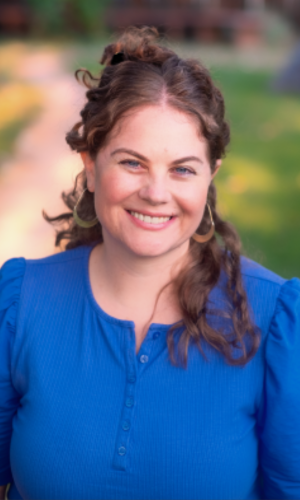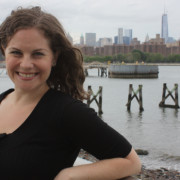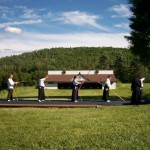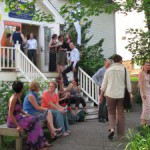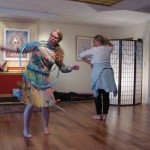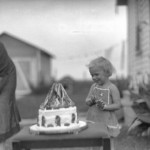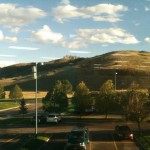Thursday
Buddhism, Psychedelic-Assisted Therapy and the Spiritual Path: An Interview with Dr. Sara Lewis
by Jillian Johnson
Register for the Buddhism, Psychedelic-Assisted Therapy and the Spiritual Path One-Day Retreat
One of the five main precepts in Buddhism is to avoid intoxicants, and it is clear that the use of substances can lead to spiritual bypassing. Yet many renowned practitioners in the West have talked openly about psychedelics as a catalyst to spiritual awakening that led them to the Dharma. Today, we sit down with Dr. Sara Lewis, co-founder of the Memoru Center for Visionary Healing Arts in Boulder, Colorado, and the Center for Psychedelic Studies at Naropa University, where she also served as an associate professor, and author of Spacious Minds: Trauma and Resilience in Tibetan Buddhism, to discuss the use of psychedelics in therapy and along one’s spiritual journey. In this interview, Sara provides us with her personal and professional perspective while considering how such practices may intersect, or not, with the Buddhist path.
Dr. Sara Lewis will hold an online mini-retreat, Buddhism, Psychedelic-Assisted Therapy and the Spiritual Path, through Shambhala Online on July 20, 2025. Click here to learn more and to register.
Jillian: Hi Dr. Lewis, thank you so much for being here with us today to share more about your work and knowledge in the field of psychotherapy and the implementation of psychedelics in mental health settings and spiritual pursuits.
Would you please tell us a little bit about your ‘why’ behind your work in mental health and how it expanded into the area of psychedelic-assisted therapy?
Dr. Lewis: I have long been interested in the mind: concepts of mind, the beauty and the challenges of the mind, and what it means to be human. As an anthropologist of religion and a psychotherapist, I am also deeply interested in how our connection to the divine changes across culture. In one way or another, I have been involved in the field of psychedelic studies for the last twenty years, yet it is more recent that psychedelic therapy has become more mainstream. As a Buddhist, I continue to see my clinical work as a skillful means to work with suffering in the world.
Jillian: How fascinating. We heard you opened a new clinic? Congratulations and please tell us more!
Dr. Lewis: Yes! Memoru Center for Visionary Healing Arts is a contemplative-based psychedelic training institute and community clinic where we offer legal psychedelic therapy. We can accept out of state clients who wish to travel to Colorado for a psilocybin experience. The Memoru clinic has a strong connection to Naropa University, where most of the cofounders have either worked as faculty or completed their studies.
Jillian: That’s very exciting, congratulations again! Speaking of legal psychedelic therapy, what do you feel are the current social and political climates surrounding the utilization of substances (primarily psilocybin and MDMA) in controlled mental health and spiritual settings? Are you noticing more or less acceptance in your typical day-to-day professional and personal interactions than in recent years?
Dr. Lewis: In general, there is a lot of interest and excitement for the therapeutic use of psychedelics. Many people understand that among veterans, abuse survivors, and others with PTSD, our standard treatments often fall short. As well, there is deep potential for plant medicines and psychedelics for those navigating the end of life. At Memoru, we will have a family program that aims to work with entire families–this might be when one person is at the end-of-life, navigating the post-partum period after birth, couples work, or a veteran returning home. When psychedelic care is done in a way that is slow, intentional and safe, I think there is significant support. At the same time, our basic health care infrastructure is not really set up to easily make this type of work accessible. Psychedelics do not fit easily into a capitalist system and without sounding too conspiratorial, the global Big Pharma system has many reasons to hinder the kind of paradigm shift many of us interested in psychedelic-assisted therapy are hoping for. Still, I believe that most of us yearn for change. With psilocybin now legal in various capacities in Oregon, Colorado and most recently, New Mexico, I believe in the next 5-10 years we will see a significant shift in accessibility of these modalities in North America and around the globe.
Jillian: Thank you so much for this thoughtful response, Sara. It is comforting to know that all areas of support are being explored for those seeking treatment and their families. Do you feel momentum and public support will eventually result in the integration of psychedelics into mainstream healthcare?
Dr. Lewis: Absolutely. And this could go the other direction as well if we do not take seriously the ethical responsibility to work with these medicines in a safe way. Many cultures across the world understand plant medicines to be living beings with sentience. They shouldn’t be “taken” in an extractive way. If we can relate with the cultures ethically who are stewards of these medicines, and collaborate and learn from them, I think we may have good results. For society as a whole to open up to them, I think we are in a critical period of needing to demonstrate that as a human society we can be trusted with these powerful agents. It’s up to us! But I feel the plants and fungi also want to help.
Jillian: I love your statement “…I feel the pants and fungi also want to help” and the care you show towards our Plantae and Fungi kingdoms. Have you noticed an increase in the number of patients and clients willing to consider psychedelics as part of their treatment plan for depression, anxiety, addiction, PTSD, etc.?
Dr. Lewis: Yes, very much so. Many people have earnestly tried conventional therapies without much relief. There are also many people seeking to work with suffering within the human condition in a way that honors and deepens their spiritual path. So there’s sort of a question about whether the work is “mental health work,” “spiritual work,” or something else. There is also a lot of joy, beauty and connection, something that may not be fully honored in a traditional treatment plan that tends to focus rather narrowly on the eradication of symptoms.
Jillian: It sounds like a very integrative approach that is catered to each individual’s unique needs and requirements, which is still lacking in many areas of healthcare. Would you tell us more about a situation(s) where the assistance of psychedelics, in a therapeutic application, aided a client in a breakthrough (mental, emotional and/or spiritual) that may not have occurred, or may have taken longer to occur, with more traditional mental health practices? Are you able to expand on the experience, at least from your perspective, and how that felt?
Dr. Lewis: I have had so many clients with intergenerational and ancestral experiences, even when they weren’t necessarily seeking that out. This has looked like deeply experiencing and seeing the ways that an ancestral burden has been passed down through the ages, visitations from elders who have passed, and sometimes a deep experience of connection and homecoming into one’s ancestral lineage. This happens so frequently that I myself, have embarked on a formal process of Ancestral Lineage Healing over the past year to better learn to work with my own spiritual lines. We will have more on this in the mini-retreat!
Jillian: This sounds not only incredibly interesting, but heart-warming as well. What a beautiful experience for both you and your clients. I am intrigued to hear more at the mini-retreat! In which situation(s) do you recommend someone not take psychedelics or partake in psychedelic-assisted therapy if it is a path they are interested in pursuing for their mental health and/or spiritual journey?
Dr. Lewis: These agents can be very powerful and it’s important to know if it’s the right time. I receive many referrals for people who have had negative even traumatic experiences resulting from psychedelics. Beyond contraindicated conditions like psychosis and mania (though even those who have these histories may be able to work in psychedelics under certain conditions), I wouldn’t recommend jumping into working with them if things aren’t stable enough to be able to accommodate potentially big and sometimes disruptive shifts. Sometimes these medicines work through disruption and dissolving: this could be to harmful patterns, misperceptions, ego-clinging, itself, or even the dissolving of relationships, career or other major disruptions.
Jillian: This is a very strong point to consider. Thank you for mentioning ‘being ready’ for shifts. While it is often said “The only constant change,” it is important to remember to be as grounded as possible before inviting a powerful catalyst for said change. What would you recommend as some of the “should” and “should nots” before holding a psychedelic session in terms of choosing an appropriate environment, monitoring one’s current mental state, integrating other practitioners and/or professionals, etc.? In a sense, what would you recommend in terms of setting yourself up for an enlightening experience?
Dr. Lewis: Most people do not need to work with a psychedelic therapist or clinician to have a safe and meaningful experience. This was recognized in the state of Colorado that has approved personal use of psilocybin mushrooms for anyone 21 years and over. Colorado also allows for individuals to embark on training as facilitators who do not hold a clinical license, again recognizing that many people can be trained to hold space for someone else ethically and with care. However, if the intention is really to engage in therapeutic work, it would be important to seek out a trained and licensed clinician. Sometimes it can be hard to really discern whether the work is “therapeutic” or whether it is “spiritual.” But this isn’t a new problem. Many cultures around the world do not separate the paths of healing and spirituality. What is most important is to feel that the setting and the practitioner is slow, intentional, and rooted in some kind of practice lineage. I would not get involved with anyone who doesn’t seem to have any mentors, elders, or community of accountability.
Jillian: Very true, consistent and quality integrative care that takes into account physical, mental, spiritual, and emotional health of an individual is a hurdle that seems to continually appear, at least in American culture. On a more casual note, if you were talking freely (perhaps in a bar) to a captivated audience, what would your elevator pitch be when introducing a metaphysical discussion on the topic of psychedelics in therapy or on one’s spiritual journey?
Dr. Lewis: I probably wouldn’t make one. A person really needs to feel the call, so to speak, on their own! If you listen and hear the call, however, many of us all across the globe would love nothing more than to dive into that conversation!
Jillian: What a conscientious approach. Wait for the invitation. And now for our final interview question, what has the use of psychedelics done for your personal spiritual growth? Do you have any stories you’re willing to share with us?
Dr. Lewis: Yes, but I will save these for the mini-retreat. Hope you can join!
Thank you, Sara, we’re looking forward to it! Myself and Shambhala Online thank you for taking the time to answer our questions about these exciting advances in patient/client care. You have touched on many dynamic aspects regarding the use of psychedelics in client care and we are eager to dive deeper on July 20!
Dr. Sara Lewis is Co-founder of Memoru Center for Visionary Healing Arts, a psychedelic clinic and training institute in Boulder, Colorado. She served as Associate Professor at Naropa University in Buddhist-Informed Counseling, where she also co-founded the Center for Psychedelic Studies. Sara is author of Spacious Minds: Trauma and Resilience in Tibetan Buddhism, an ethnographic study of mind, memory and recovery from collective trauma in the Tibetan exile community. She teaches in Shambhala on the topic of Buddhism and psychedelics, and has also served in a number of leadership roles, including a term on the Interim Shambhala Board.
Entries filed under Community Articles
The Passing of Acharya Allyn Lyon – HIGHLIGHT
A letter from Acharya Emily Bower and Cynthia Mackay Dear Sangha Friends, Acharya Allyn Lyon passed away just before midnight (Mountain Time) on Friday, November 20, in Denver, Colorado. She will be missed by so many of us. Allyn had been unconscious in the Swedish Hospital ICU in Denver ... continuePosted November 25, 2015 by CGH
Beginner’s Heart and the Way of the Bow
Kyudo students meet their new sensei during the most recent Kyudo Assembly at Karme Choling by Adrienne Kehn, with photos by Gary Vu A beautiful day at the Karme Choling matoba (all photos courtesy of Gary Vu) Since my beginnings in the art of Kyudo, the Way of the ... continuePosted October 13, 2015 by Adrienne
Money and Inspiration – HIGHLIGHT
COLUMN: Shambhala Economics Welcome to Shambhala Economics, a column in the Shambhala Times where we publish articles on uplifted ways to view and engage in the economic side of life. Layth Matthews who is a long time student of Shambhala Buddhism and author of, “The Four Noble ... continuePosted October 2, 2015 by
Building Changes
COLUMN: Shambhala on the Move Updates from Halifax by Michelle Munro, Center Director Insurance Work This winter, as did many Halifax residents, we incurred water damage to various sections of our building. Due to the heavy volume of claims, we are just now getting this sorted out . To make ... continuePosted September 28, 2015 by
A Good Salon – HIGHLIGHT
COLUMN: Good Practice A Window into the Playful Space of Cultural Engagement at the Bellingham, WA Shambhala Center article by Zoey Moyle Sakyong Mipham Rinpoche has been strongly encouraging the Shambhala community to actively live the culture of kindness. Outside the formal practice container of retreats, however, we need ... continuePosted September 26, 2015 by
The Flip of Cheerfulness – HIGHLIGHT
COLUMN: Aging in Enlightened Society Exploring the Warriorship of Aging Interview with Acharya Emeritus Jenny Warwick by Sarah Lipton “For what it’s worth, one of the commonalities I have with other folks my age – a physical edge for me – is rheumatoid arthritis in my upper back. It acts ... continuePosted September 23, 2015 by Sarah
The Range of Emotions… – HIGHLIGHT
…Inspired By a Child’s Birthday COLUMN: Children and Family article by Heather Grimes edited by Renée Picard Photo: Harry Walker / Wikimedia Commons (Public Domain) originally published on elephantjournal.com Friday was two days after my daughter Opal’s fifth birthday. We went to Sunflower Farms with my parents who were visiting from Ohio. My ... continuePosted September 18, 2015 by
Inspiration and Money – HIGHLIGHT
miksang image by Charles BlackhallCOLUMN: Shambhala Economics Welcome to Shambhala Economics, a column in the Shambhala Times where we publish articles on uplifted ways to view and engage in the economic side of life. Layth Matthews who is a long time student of Shambhala Buddhism and author ... continuePosted August 31, 2015 by
Can Home Cooking Restore Enlightened Society? – HIGHLIGHT
COLUMN: In Everyday Life by Marcella Friel, Crestone, Colorado “Internal drala also comes out of making a proper relationship to food…. You can take the time to plan good, nutritious meals, and you can enjoy cooking your food, eating it, and then cleaning up and putting the leftovers ... continuePosted August 26, 2015 by
Adventures in Doll-Making – HIGHLIGHT
COLUMN: Children and Family Why our Imperfect First Try was a Winner article by Heather Grimes edited by Renée Picard photo courtesy of the author originally published on elephant.com We have no idea when inspiration will strike. It can come like a jolt, or as a slow-percolating notion. The thing is, as ... continuePosted August 24, 2015 by Dan
Being Old at Encampment – HIGHLIGHT
COLUMN: Aging in Enlightened Society Reflections on attending the 2015 Trident Assembly during Magyal Pomra Encampment on the Kasung Encampment Grounds in Tatamagouche, Nova Scotia by David Whitehorn Being 73 years old, my first thought, upon seeing an announcement that a three day “Trident Assembly” would be held ... continuePosted August 21, 2015 by
Child-free in the Modern World – HIGHLIGHT
miksangarticle by Crystal Gandrud About a year ago my 10-year-old niece asked me if I was happy without children. I replied in the affirmative, adding, “And I really like spending time with you.” She was pensive for a while and then she said, “I think maybe I ... continuePosted August 19, 2015 by
Contemplating an Empty Nest – HIGHLIGHT
Colorado Springs Afternoon light through a windowCOLUMN: In Everyday Life article and photos by Elaine Logan I’m at the gas station. It’s been a long day and I have a long drive home ahead of me. I feel sad, the kind of sadness you feel when it seems ... continuePosted August 12, 2015 by
Family and Children’s Programming Survey
The following request is from the Working Group for Children & Families under the Office of Societal Health and Wellbeing: Calling all Centers and Groups! Do you currently offer programming for children and families? Do you want to connect, deepen, or expand your offerings? Do you currently ... continuePosted August 3, 2015 by David_Brown
The Barnacle’s Roar – HIGHLIGHT
Coming Home from Enlightened Society Assembly article by Emma Cataford, Gampo Abbey photos by Jacqueline Larson and Naomi de Ville Between June 24th and July 3rd at Dorje Denma Ling, around sixty practitioners attended Enlightened Society Assembly led by Acharya Marty Janowitz and Shastri Mary Campbell. Given the shortened ... continuePosted July 29, 2015 by
![]() RSS feed for the Community Articles category
RSS feed for the Community Articles category
View all posts from authors in Community Articles: jillian_johnson


